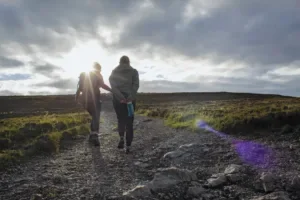AUSTIN, Texas —For all of his adult life, Kurt Bartelmehs has been the one in the crowd who knew more about computers than anyone else. He’s also been the one who knew the most about sound systems and other electronic equipment.
When he was in graduate school, he had seven television sets in his house and stereo speakers in every room.
So it’s not surprising that he’s the technical brains behind the Information Technology (IT) infrastructure of the new Applied Computational Engineering and Sciences (ACES) building. The structure contains the ultimate in audio/visual equipment and 5,500 connection points to go with 1.3 million feet of copper telecommunications cabling.
Bartelmehs’ job as program manager for information technology at ACES is, however, something of a leap from his graduate school training. He earned a doctorate in theoretical chemistry from Virginia Tech.
But his work in that science, he said, was good background for his current job because it had similarities to the computational visualization research being conducted at ACES. As he pointed out, it helps to understand the work of the professors and students who will use the building.
Bartelmehs came to the ACES building in a roundabout way. Already at UT, he was handling technology and audio/visual systems for the College of Natural Sciences and the department of geological sciences. One afternoon when he was leading a tour through one of his retrofitted classrooms, one of his guests was Peter O’Donnell Jr., the donor behind the ACES building.
O’Donnell asked Bartelmehs to look over the audio/visual (A/V) and technical design specifications for the new building, which already was under construction. Bartelmehs said he was alarmed at the plans.
“Nowhere was there a place to plug in a computer,” he said. “All the rooms were different. There was no standardization in terms of technology. Some rooms had a TV in the corner — and that was it.”
Bartelmehs reported back to O’Donnell that if the design were implemented, millions of dollars in equipment would be too complicated to operate. O’Donnell began calling and asking him for advice and eventually Bartelmehs took over the project.
Bartelmehs employs an unorthodox mix of instinct and technical knowledge in his work.
“I had a warm fuzzy feeling about the remote-control system we have in the ACES building,” he said, recalling the first time he saw the Crestron e-control system. “I just knew it was the right one.”
But at the same time, he said, “People tell me I have a good sense of logic.”
Bartelmehs exhibits a contagious excitement about technology and a keen sense of what makes it user-friendly. The results are easy to operate high quality and state-of-the-art IT equipment for UT faculty and students.
Bartelmehs has retrofitted and equipped auditoriums and rooms in seven buildings so far on campus. His goal is to standardize the interface to IT equipment and computers University-wide.
“That’s the problem with technology today. There’s no uniformity, no standardization. There are too many choices, too many buttons,” he said. “If it’s more than one button, there are too many buttons.”
Indeed, Bartelmehs’ systems are the simplest of the simple. Using a browser interface to control sound, videos, slide presentations and other media, users operate equipment with a touch-screen. Controls are as simple as a button on the screen that says “Turn On.”
The high tech wizard believes instructional equipment should be so easy to use that technical personnel are not needed to assist. He also understands the tendency to press a lot of buttons on remote controls and electronics, even when it’s not clear what they’re for. That’s why he installs covers over the control buttons of some devices, exposing only the on/off switch for the user.
Bartelmehs gives users a brief equipment orientation each semester. Further support is offered on his individualized web sites for each building. His efforts to keep things simple apparently are working because he rarely gets calls for technical support. “I really get energized when people use my stuff,” he said. “I couldn’t be happier doing what I do.”



